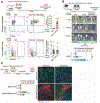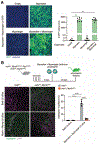Enveloped viruses pseudotyped with mammalian myogenic cell fusogens target skeletal muscle for gene delivery
- PMID: 37075755
- PMCID: PMC11181154
- DOI: 10.1016/j.cell.2023.03.033
Enveloped viruses pseudotyped with mammalian myogenic cell fusogens target skeletal muscle for gene delivery
Erratum in
-
Enveloped viruses pseudotyped with mammalian myogenic cell fusogens target skeletal muscle for gene delivery.Cell. 2023 Aug 3;186(16):3520. doi: 10.1016/j.cell.2023.06.025. Cell. 2023. PMID: 37541201 No abstract available.
Abstract
Entry of enveloped viruses into cells is mediated by viral fusogenic proteins that drive membrane rearrangements needed for fusion between viral and target membranes. Skeletal muscle development also requires membrane fusion events between progenitor cells to form multinucleated myofibers. Myomaker and Myomerger are muscle-specific cell fusogens but do not structurally or functionally resemble classical viral fusogens. We asked whether the muscle fusogens could functionally substitute for viral fusogens, despite their structural distinctiveness, and fuse viruses to cells. We report that engineering of Myomaker and Myomerger on the membrane of enveloped viruses leads to specific transduction of skeletal muscle. We also demonstrate that locally and systemically injected virions pseudotyped with the muscle fusogens can deliver μDystrophin to skeletal muscle of a mouse model of Duchenne muscular dystrophy and alleviate pathology. Through harnessing the intrinsic properties of myogenic membranes, we establish a platform for delivery of therapeutic material to skeletal muscle.
Keywords: cell fusion; gene therapy; muscular dystrophy; myomaker; myomerger/myomixer; viral pseudotyping.
Copyright © 2023 Elsevier Inc. All rights reserved.
Conflict of interest statement
Declaration of interests The authors declare competing financial interests: S.M.H. and D.P.M. have filed patent applications on this work through Cincinnati Children’s Hospital Medical Center.
Figures






Update of
-
Enveloped viruses pseudotyped with mammalian myogenic cell fusogens target skeletal muscle for gene delivery.bioRxiv [Preprint]. 2023 Mar 18:2023.03.17.533157. doi: 10.1101/2023.03.17.533157. bioRxiv. 2023. Update in: Cell. 2023 May 11;186(10):2062-2077.e17. doi: 10.1016/j.cell.2023.03.033. PMID: 36993357 Free PMC article. Updated. Preprint.
Comment in
-
Muscle fusogens go viral for gene delivery to skeletal muscle.Cell. 2023 May 11;186(10):2041-2043. doi: 10.1016/j.cell.2023.04.021. Cell. 2023. PMID: 37172560
References
Publication types
MeSH terms
Substances
Grants and funding
LinkOut - more resources
Full Text Sources
Other Literature Sources
Molecular Biology Databases
Research Materials

